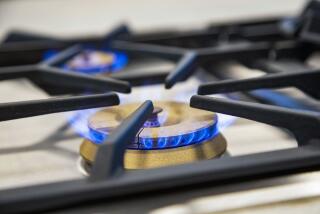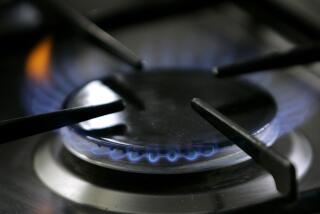Taking the Heat
e were either gas or electric chefs-in-training, depending on our family’s stove. And today, many of us are still most comfortable preparing meals on the type of stove top we first learned to cook on. But with all the new technology, now may be the time to step out of the comfort zone and try one of the high-tech cooktops.
Such as:
* ribbon-radiant and induction electric tops that respond with heat and light almost as quickly as gas;
* an extra-low gas burner setting that stabilizes temperatures for sensitive dishes such as Hollandaise and chocolate sauces;
* sealed gas burners that don’t have to be taken apart to be cleaned;
* and a cooking surface that combines electric coil elements with halogen burners and grills.
OK, so how do you decide?
Let’s ask some experts.
Few people know more about how food reacts under heat than professional chefs. Most restaurants use commercial-style cooktops that burn hotter and cook faster than traditional residential gas burners. But at home, some chefs prefer the simpler route.
Take Louie Francis Jocson, corporate chef for Harpoon Henry’s Seafood Restaurant in Dana Point as well as the Wind & Sea restaurant chain in Dana Point and Hawaii.
“I have a regular Kenmore gas stove that you find in any typical home,” he said. “The best thing about gas is that it shuts off instantly. With electric you have to pull your pot off and if your kitchen is small like mine, that would be a hassle.”
Jocson, who lives in Laguna Beach, has catered events in people’s homes, forcing him to cook on a variety of burners. He has a few good things to say about electric cooktops.
“If I want to sear a 2- or 3-pound roast, on a gas burner as soon as you put it in the pan it cools down, whereas with electric it takes so long for the heat to get really hot, the pan sustains the heat,” he said.
Bret M. Young, chef at Luciana’s Ristorante in Dana Point, also thinks gas is the best heat source for cooking. But he prefers the vintage gas stove tops to the modern ones.
“Nowadays the gas stoves have smaller lines to the burners, and the flames don’t burn as hot. It’s probably a safety feature,” he said. “But those old stoves are great for cooking.”
At home, he uses a gas stove made in the ‘60s.
But maybe appearance matters to you. If so, there are cooktops that no longer hug a wall with a hood overhead. Some come with retractable downdraft vents that can be pushed out of the way when not in use.
Stainless-steel, commercial-style cooktops are popular with people who enjoy gourmet cooking, but they come at a premium price: as much as $1,200.
“Stainless steel is equated with higher-end and professional cooking,” said Wendi Young of Squires-Young Design in Aliso Viejo. “Kitchen designers like me like the look of stainless steel. [We use it] to introduce another material into the decor.”
There’s also the question of power: The commercial-style cooktops burn hotter (8,500 to 12,500 British Thermal Units) and cook faster than traditional residential gas burners (8,000 to 10,000 BTUs). “Water boils faster with higher BTUs,” she said.
In deciding what type of cooktop is best for you, chef Young says, consider your purchase as carefully as you would a car purchase: Check out all the options available.
“Comparing BTUs is like understanding the difference between a V-8 and a four-cylinder,” he said.
And consider what you’ll be cooking. “If you want to heat corn tortillas, gas is the way to go because you can put them right on the burners,” he said. “With electric, they just burn.”
The biggest drawback with gas used to be that it didn’t cook evenly, especially with low heat, according to kitchen designer Young.
Now that has changed.
Extra-low simmer capabilities were introduced in gas cooktops as early as 1993, but many people aren’t aware of the technology, said Christine Gardiner of Thermador, a Los Angeles-based manufacturer of kitchen appliances.
An extra-low burner setting emits a consistent heat because the flame is set to cycle on and off at set intervals.
Of all the electric cooktops, the familiar coil burners heat the quickest and are most forgiving with imperfect pots. These stove tops are also the cheapest of the electrics, costing from about $150 to $300.
Solid electric surfaces run wire through cast iron that is fused to the cooktop, usually glass. They are slow to heat and their popularity is dwindling because of the more efficient models on the market at comparable prices (around $400). “These types are hard to find now,” says Wayne Small, manager of Renwes Sales in Lake Forest.
Smooth-top electric cooking surfaces get thumbs up for their easy cleaning and because they can blend in with the counter top. They most often have radiant or halogen elements.
Radiant elements have coils set under a ceramic glass top that resists heat and sudden temperature changes. They are also stain resistant and range from $400 to $700, says Small.
Ribbon-radiant tops respond with heat and light in as little as three seconds--about half the time of previous radiant elements. Pans should have flat bottoms and shouldn’t extend more than an inch beyond the heating element for best results. They cost from $500 to $700.
Halogen is similar to radiant heat with the addition of quartz tubes filled with halogen gas. These release infrared cooking waves. Halogen is often paired with radiant elements: While the halogens go on and off, the radiant element keeps a steady heat.
Halogen surfaces can range from $600 to $900.
Induction uses magnetism, making it an electric system that is as instant in heat response as gas. It works by a sensor triggering an induction coil that sets up an electromagnetic field that reaches about an inch off the surface. It heats only the pan, not the cooktop. When the pan is removed, the cooktop is cool. Elements can be placed in ceramic tiles that can be moved throughout the kitchen. They range from $700 to $1,000.
More to Read
Eat your way across L.A.
Get our weekly Tasting Notes newsletter for reviews, news and more.
You may occasionally receive promotional content from the Los Angeles Times.









